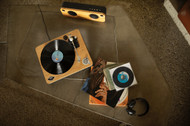How To Set Up A Record Player
Posted by House of Marley on Jun 17th 2022
You recently purchased a new record player, and you're ready to start enjoying the warm sound of vinyl. But sometimes setup guides that come with turntables are easy to follow, while others are like an IKEA instruction booklet gone wrong.
But don’t worry, we'll get you up to speed (33 1/3 RPM of course). Keep reading to learn how to set up your record player to get the best listening experience.
How to Set Up a Record Player with House of Marley
Learn how to quickly set up your turntable with these step-by-step instructions from our product manager, Josh.
Find a Flat Surface
Before you get started, find a flat, even surface for your record player. If your record player is on a slanted surface it might end up off-balance, meaning the needle won’t be able to follow the groove. This can result in skipping or damage to your records.
Though some of us have a knack for eyeballing flat surfaces, you should always double-check with a bubble level—or similar smartphone app— to ensure the surface is flat enough for your record player. If your record player has adjustable rubber feet, you can use them to compensate for an uneven surface. In that case, use the level to check that your record player itself is sitting evenly.
Some of us don’t have the luxury of perfectly flat surfaces. Hey, older homes have a lot of character, but sometimes the floors shift and sink over the years. If your record player doesn’t have adjustable feet to compensate, you can place shims—thin wood chips work best, but baseball cards are a solid option—underneath your record player to even it out. As always, double-check with your bubble level to make sure everything is completely even.
Attach the Belt and Platter
Now that you have a stable surface for your record player, you’re ready to attach the belt and platter. Belt-driven turntables use a rubber belt, motor and pulley to keep the record spinning. If you have a direct-drive turntable without a belt, you can place the platter on the base and skip the rest of this section.
Attaching the belt and platter to the base takes just a few simple steps.
- Flip the platter over to locate the belt.
- Gently place your thumb under the belt, and lower the platter onto the base.
- Place the platter over the spindle and loop the belt around the pulley.
- Place the slipmat on the platter.
If the belt is fitted correctly, you’ll notice some resistance when you manually rotate the platter. If it’s extremely loose, repeat the steps to make sure the belt stays wrapped around the pulley.
Balance the Tonearm
Now you have a record player that looks like, well, a record player. It might be tempting to start playing records right away, but first, you need to balance the tonearm. When there is equal weight on both ends of the tonearm (zero grams), it will “float” over the platter on its own—which is exactly what you want.
Here’s how to balance the tonearm:
- Place the counterweight on the back of the tonearm.
- Rotate the counterweight to adjust the amount of weight. Rotating it counterclockwise increases the weight and vice versa.
- Continue adjusting the counterweight until the tonearm floats parallel to the platter.
- Lock the tonearm back in place, and turn the black dial on the counterweight to “zero.”
If you have a hard time getting the tonearm to float, no worries. It takes some trial and error, but we have faith in you!
Set the Tracking Force and Anti-Skate Setting
With the tonearm balanced, you’re ready to set the tracking force and anti-skate setting.
Tracking force is the amount of weight that a turntable cartridge can handle. Too much force will cause the needle to cut into the vinyl and damage your record. If you don’t apply enough weight, the needle will jump out of the groove and skip across the record. It’s a real Goldilocks situation, but it’s easier than it sounds to get it right.
Anti-skate is a setting that helps the needle stay in the middle of the groove. As a record spins, the needle gets pulled toward the center—sometimes too much, which causes skipping. Anti-skate compensates by pulling the tonearm in the opposite direction.
So what’s the optimal amount of tracking force and anti-skate resistance? The answer depends on what type of cartridge you have. Before following the steps below, check with the manufacturer for the recommended tracking force.
- Make sure the tonearm is in the locked position.
- Rotate the counterweight until the dial displays the correct weight.
- Turn the anti-skate dial to match the tracking force. For example, if you have 2.5 grams of tracking force, adjust the anti-skate dial to 2.5.
Assuming the tonearm is balanced and you adjusted the counterweight correctly, you should be good to go. Although it isn’t required, you can also use a digital stylus gauge to make sure you have the correct tracking force.
Connect Your Speakers
You’re almost ready to listen to your records! Connecting your speakers to the record player is the last step. Whether you have traditional speakers with RCA inputs or Bluetooth speakers, we have you covered.
How to Connect Wired Speakers
There are several different ways to connect wired speakers, and it depends on the type of hi-fi system you have. For example, you can integrate home receivers, surround speakers, power amplifiers and so much more—but we’ll keep things really simple.
Before connecting wired speakers, you need to find out if your record player needs an external phono preamp. Phono preamps amplify the signal to make it loud enough for your speakers to reproduce. Most modern record players, like our Stir It Up Turntable, have a built-in preamp, so you can connect your system without buying one separately.
If you have a built-in preamp, use RCA cables to link your record player directly to your speakers. If you don’t have a built-in preamp, connect your record player to a phono preamp before connecting the speakers.
How to Connect Bluetooth Speakers
Bluetooth speakers, like our Get Together Duo, are a seamless way to enjoy records wirelessly. Check out our guide about Bluetooth speakers and True Wireless Stereo for a deeper explanation of how it works.
Bluetooth record players, like our Stir It Up Wireless, connect to compatible headphones and speakers with a few easy steps. Here’s a quick rundown.
- Turn on your Bluetooth speakers.
- Unpair any devices that are connected to your speakers, if necessary.
- Turn on your turntable, and put it in pairing mode.
- Wait for both devices to connect.
Connecting Bluetooth speakers to a turntable is pretty straightforward, but you may have to reset both devices to get them to pair. Understanding how a Bluetooth record player works can help you troubleshoot any pairing issues you may encounter.
Make Your Record Player a Centerpiece
If you followed all our tips, you should be ready to go! After learning how to use and maintain a record player, you can turn it into the perfect centerpiece. Turntables are more than a tool to enjoy music—they’re a way to express yourself.
The classic turntable consoles of the ‘50s had personality in droves. Back in the day, record players were statement pieces that brought a touch of class to every home—they were even built into their own pieces of beauifully crafted furniture. Traditionally, you’d find them tucked away in parlor rooms, dens and offices. But the golden era of vinyl isn’t over—you can create a unique aesthetic with your own record player.
Your record player can enhance any space, whether it’s a bedroom, living room, entertainment room or covered patio—all it takes is creativity. Place your record player in an unused nook, or repurpose a vintage piece of furniture to create a throwback vibe. Browsing Pinterest and Instagram is a great way to get inspired.
But what’s the best way to store vinyl records? You don’t have to use a milk crate! There’s a wide selection of hi-fi furniture that will display your record collection in style. Specialty online shops, like Turntable Lab, are great places to find quality furniture for turntables and vinyl records.
Enjoy the Vinyl Experience
Congrats—you’re ready to enjoy music the classic way! When you’re ready to take your listening experience to the next level, check out House of Marley turntables, Bluetooth speakers and headphones.













